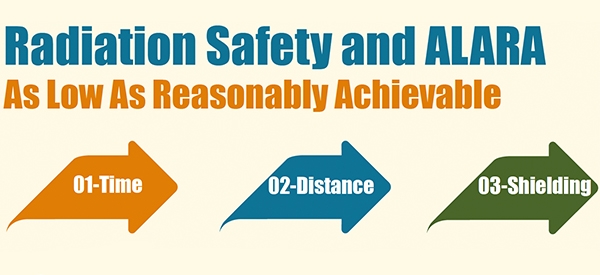What is Radiation Protection?

Radiation safety, radiological protection, health physics, and medical physics are all terms used to describe the practice of radiation protection. Radiation protection is a general term used to describe the science and practice of protecting people and the environment from the harmful effects of ionizing radiation. Radiation protection is primarily focused on ionizing radiation and reducing the amount of exposure to individuals as well as the environment.
Sources of Radiation Exposures
Radiation exposure can be classified as occupational, non-occupational (naturally occurring), and man-made sources. This radiation safety and protection resource will be focused on occupational exposure, primarily in the field of medicine, although medical radiation is classified under man-made sources.
Biological Effects of Radiation
There are two broad categories of health effects, stochastic and non-stochastic, related to radiation exposure. The severity or type of health effect is dependent on the duration and amount of radiation exposure. Stochastic refers to the probability of something happening. Consequently, stochastic effects are associated with long-term, low-level (chronic) exposure to radiation. When radiation exposure levels increase, the probability of health effects are more likely to occur, but the type or severity is not influenced by the effect. “Cancer is considered by most people the primary health effect from radiation exposure.”
Non-stochastic effects occur when an individual is exposed to high levels of radiation. The severity of the health effects increase as exposure increases. Acute exposure is when an individual receives a high-level of exposure in a short period of time. Unlike stochastic effects, acute exposure frequently results in non-cancerous health effects such as radiation burns, radiation sickness, premature aging, and even death. Medical patients who receive radiation treatments often experience some of these health effects.
Radiation Protection Basics
There are three basic concepts that apply to all types of ionizing radiation. Time, distance, and shielding are the basis of radiation protection principles.
Time
There is a direct correlation with the amount of radiation exposure received and the amount of time individuals spend near the radiation source. There are two types of exposures, internal exposure and external (direct) exposure, the focus of our attention will be on minimizing external exposure. Exposure time is the length of time and individual is exposed to the source of radiation. Minimizing the time for external (direct) exposure from gamma and x-rays directly reduces radiation dose.
Distance
The greater the distance between the individual and the radiation source, the lower their exposure. By doubling the distance between your body and the radiation source will divide the radiation exposure by a factor of 4. Halving the distance, increases the exposure by a factor of four.
Shielding
Shielding is any type of material that will absorb radiation between the individual and the source of radiation. The amount of energy emitted from the radiation source will determine what shielding material is required to effectively attenuate the radiation. The greater the shielding around a radiation source, the smaller the exposure.
For example, thick, dense shielding, such as lead, is required to protect against x-rays, while a thin piece of paper can effectively shield against alpha particles. By using absorber materials such as lead for X-rays, ionizing radiation exposures can be reduced. Shielding comes in many forms including:
- Walls, windows, control booths, and doors
- Mobile rigid shields
- Suspended transparent barriers
- Flexible (lead or lead equivalent) aprons, vests, and skirts
- Thyroid shields
- Lead gloves
- Leaded safety eye glasses (with and without side shields)

What is ALARA?
ALARA is an acronym for As Low As Reasonably Achievable. ALARA was introduced by the International Commission On Radiological Protection (ICRP) and is a radiation safety principles for minimizing radiation doses and releases of all radioactive materials by employing all reasonable methods. In addition to being a sound radiation safety principle, ALARA is also a regulatory requirement for all radiation safety programs. Time, distance, and shielding are three major principles used to minimize radiation exposure and maintaing doses as low as reasonably achievable.
Occupational Dose Limits
Occupational dose limits provide guidelines for radiation workers by establishing a maximum annual occupational dose limit. “These maximum dose limits are promulgated on the basis that when applied to occupationally exposed radiation workers they will result in a level of risk no greater than that in other occupations which are deemed to have high safety standards.” By following the ALARA concept, operational dose limits are more stringent than the maximum legal dose. Maintaining doses ALARA provide radiation workers with an enhanced safety factor by working below the legal dose limits.
| Maximum Annual Occupational Dose | |
|---|---|
| Whole Body | 5000 millirem |
| Extremities | 50000 millirem |
| Lens of the Eye | 15000 millirem |
| Fetus | 500 millirem* |
| Individuals in the General Public | 100 millirem |
Shielding From Radiation
Whenever possible, appropriate shielding should be used to provide attenuation of the radiation being delivered to the healthcare personnel who are potentially exposed. Healthcare personnel must keep all all body parts out of the direct x-ray beam. There are a variety of shielding options available and may include, but are not limited to lead or x-ray aprons, lead glasses, lead gloves, thyroid collars, and lead shields.
During diagnostic imaging and interventional procedures involving radiological technology, physicians and medical staff are exposed to scatter radiation, the energy transmitted beyond where the radiation is directed. Proper radiation protection exposure is essential to alleviating health risks and ensuring that staff can continue to perform their duties. X-ray aprons are an essential piece of radiation protective equipment for reducing ionizing radiation exposure to physicians and staff.
Materials
X-ray aprons are manufactured with 3 different types of shielding materials options including traditional lead, lightweight lead composite aprons, and non-lead aprons. Depending on the types of procedures you frequently perform, you will want to consider what X-ray apron material is right for you. Each material has unique benefits and features that you will want to evaluate before making your decision including weight, cost and durability. The features of the X-ray aprons will depend on the specific procedure performed, length of the procedure, and the frequency of the procedure.
Apron Style
Determining which x-ray apron style is right for you may seem overwhelming but the process can be simplified into several easy steps by evaluating the type of radiation protection required and what specific style is most appropriate for your application. The styles available include frontal protection aprons, front and back protection aprons, full overwrap protection aprons, quick drop aprons, special procedure aprons, and vest/skirt combinations. We have created a helpful white paper, Choosing An X-Ray Apron: The Top Four Considerations, to assist you in selecting the right lead apron for your application.
Lead Glasses
Exposure to X-ray radiation is cumulative. As a result, it is important for doctors, technicians, and hospital staff to protect all areas of the body from radiation exposure. Protecting the eyes from radiation is extremely important as the eyes are highly sensitive to ionizing radiation exposure.
Make sure to visit our article on How do lead glasses protect your eyes? to learn about the importance of proper radiation protection for your eyes.
How Do I Order Prescription Lead Glasses?
Currently, we have over 75 different styles of lead glasses that are available in a variety of colors and enhancements.
- Oakley Lead Glasses
- Nike Lead Glasses
- Wiley-X Lead Glasses
- Classic Lead Glasses
Lead Gloves
Exposure to the hands and extremities has been a concern in radiology. Lead gloves are designed to reduce the amount of scattered radiation to the surgeon’s hand when exposed during a procedure using ionizing radiation. Selecting lead gloves that provide proper radiation protection while allowing the surgeon dexterity with instruments is crucial in today’s interventional radiology procedures. Learn more by reading how to Protect Your Hands During Cardiac Catheterization.
It was our goal to create a resource that would provide a high-level overview of radiation protection and radiation safety concepts. This resource will continue to expand as we explore and discuss more topics in radiation protection. If you would like more information regarding a specific topic or have a suggestion for an upcoming article, please contact us either via email or on social media.
